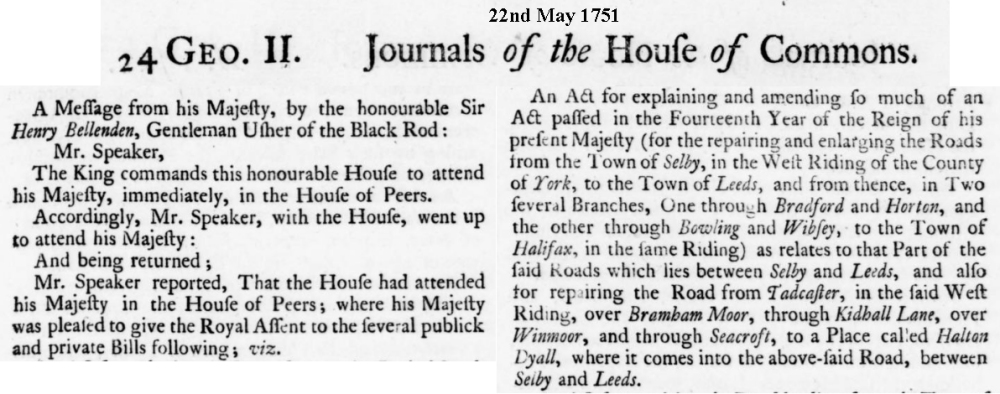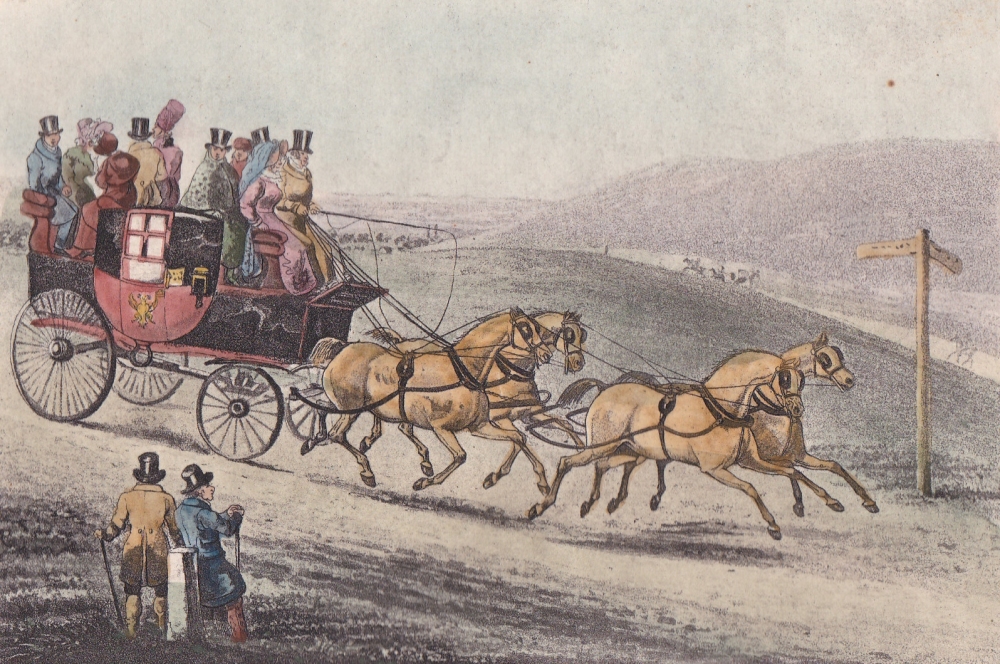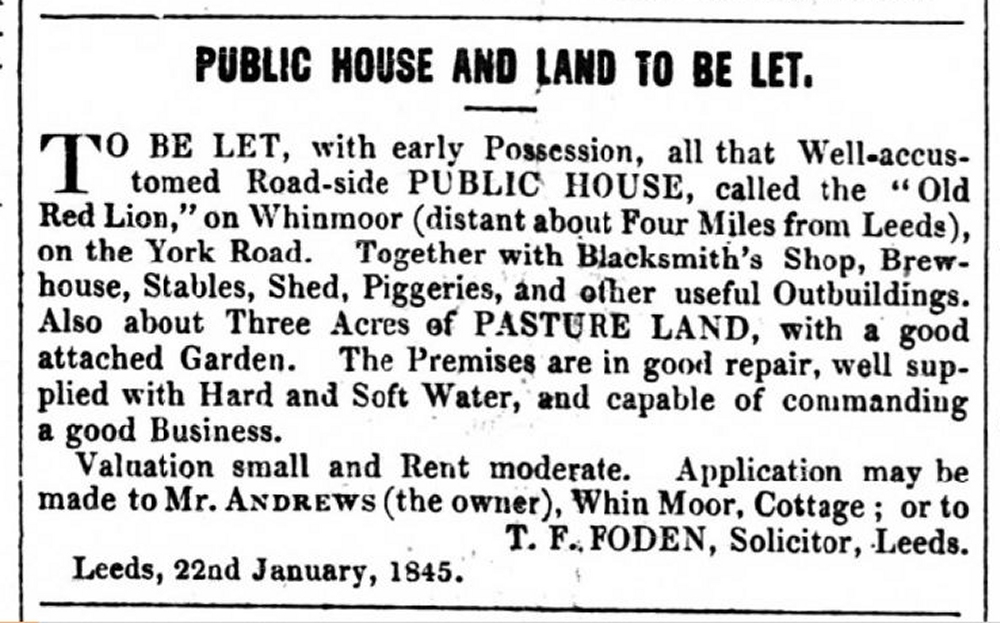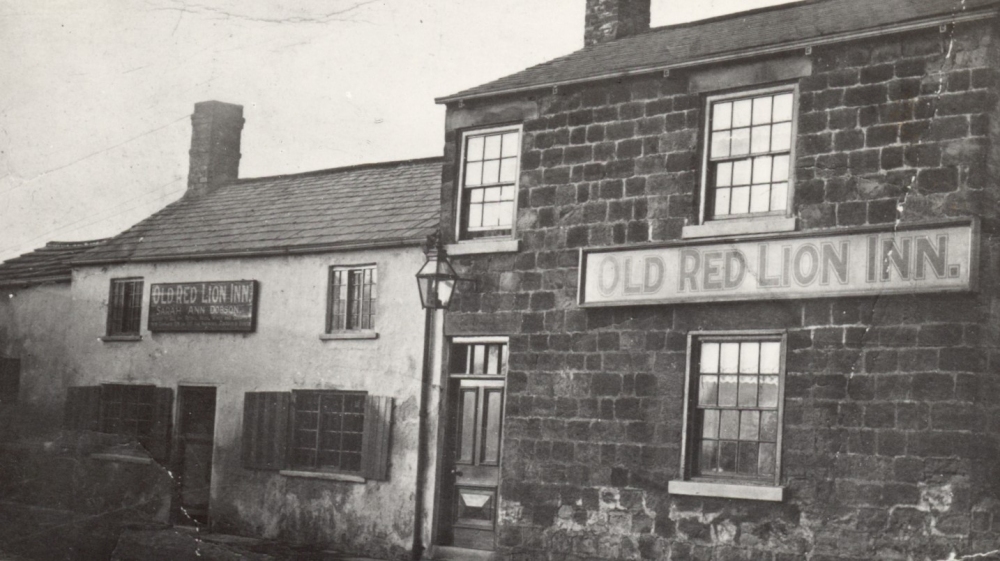|
The currently closed (August 2022) public house "The Old Red Lion, Whinmoor" stands on the Leeds to York Road / A64 near to Seacroft, West Yorkshire. It lies just within the boundaries of the ancient Parish of Barwick-in-Elmet which at the time the inn was constructed extended to the nearby A64/A6120 roundabout. The inn is one of the few within the Parish for which we have an almost full history. The ancient road between Leeds, starting at Halton Dial, and Tadcaster which included crossing Whinmoor was turnpiked by an Act of Parliament in 1751. Most of Whinmoor was common, moor or waste land under the jurisdiction of the Manor of Barwick with Scholes and was likely to have been a treacherous boggy area with multiple paths prior to the turnpiking of the route. Many improvements would have been made including widening and straightening of the route and, no doubt, this included close to where the Old Red Lion Inn is located.  1751 Act of Parliament for Turnpike Road across Whinmoor approved. In the 1750s the Manor of Barwick and Scholes was owned by the Gascoigne family of Parlington Hall with Sir Edward Gascoigne then Lord of the Manor. At a Court held for this Manor at Barwick on Wednesday 15th April 1761 John Cawood, a Blacksmith, formerly from Scholes but then of Whinmoor and Ellen his wife and their heirs are recorded in a "Grant of a parcel of Land on Winmoore as copyhold" described as "all that now erected Tenement or Dwelling-house with appurtenances situate and being on Winmoore at a certain place there nigh the Turn-pyke Road leading from Leeds to Tadcaster (called Grimesdyke Hill) wherein the said John Cawood now dwells, which said Tenement has lately been so erected and built by and at the proper costs and charges of the said John Cawood, and all that piece or parcel of ground, on part of which the same Tenement is so erected , containing by estimation two acres next adjoining and extending from the said now erected Tenement towards the East and adjoining the Turn-pyke Road on the south, as the same parcel of Land is now fenced in, divided and enclosed from the said common or waste thereof called Winmoore."  The Property was owned as part of the Manor of Barwick with Scholes. The Cawood's paid an incoming fine to the Lord of the Manor and also agreed to pay him an annual 10-shilling rent at the Feast of St. Michael the Archangel (29th September). The land was held as copyhold tenure meaning it was owned by the Cawood's by copy of Manor Court Roll, they could sell, mortgage and bequeath the land but all transactions had to go though the Manor Court and adhere to the customs of the Manor. Each time this happened a payment had to made to the Lord of the Manor. The property may have originally been built as a blacksmiths shop to service the horse drawn trade that would pass on the turnpike road but it appears to have quickly also become a fully serviced Inn. It is most likely that these premises survive in the lower height western end of the current premises. In the few public house licensing records which survive in the local archives from the 18th century it is recorded that John Cawood was licenced as an alehouse keeper in the parish of Barwick-in-Elmet for a year on the 4th September 1771. John Cawood died in November 1772 and his widow Ellen continued to run the inn, listed in the licensing records in 1781. In 1785 the accounts of the Surveyor of the Highways of Barwick show a payment to "Ellin Cawood for Ale and Bread; 18 shilling 6 pence" for workers repairing the local roads. She died in February 1797 aged 74. The property and land then passed at a Manor Court held on the 18th October 1797 to Samuel Cawood of Holbeck, Leeds, a whitesmith, who was John and Ellen's eldest son and heir in law. However, he appears not to have run the business which was continued by his younger brother Leonard Cawood and his wife Mary. On the 12th April 1800 Samuel sold or transferred the property to his brother Leonard, now listed as an innkeeper of Whinmoor and Mary. The inn was probably known by the name "Sign of the Red Lion" from when first constructed in the 1760s. It is the most popular name for a UK public house. The 1st written reference to the name "Red Lion" or any name for the inn is from the 6th October 1804 in the Barwick-in-Elmet Enclosure Award. The remaining parts of the moorland and wastes of Whinmoor were enclosed and parcelled into fields by a Private Act of Parliament. In the Award document which details the results of this a new road was created at the western side of the inn and this contains a name reference: "The White Laithes Road branching out of the said York Road westward near a public house known by the sign of the Red Lyon and leading from there over allotments herein severally awarded to the said Rector in exchange and James Holliday on the said common called Whinmoor to an into certain old inclosures of the said James Holliday leading to the said place called White Laiths." Parts of this road exist today as Baildon Drive although the alignment of the north end changed when housing was constructed in the 20th century.  6th October 1804 - Barwick-in-Elmet Enclosure Award - 1st reference to name Red Lion. (Acknowledgement : WYAS, Leeds, WYL671 skin 7 - West Yorkshire Archive Service - www.wyjs.org.uk/archives) On the 18th January 1809 Leonard and Mary Cawood used the land and inn as security for a mortgage and raised £200 borrowing it from John Clemishaw, a farmer of Whinmoor. It is possible this money was used to fund an expansion of the building. This mortgage was extended to £250 in September 1812 when William Mann, a yeoman of Harewood took over the loan. William Mann died in 1825 and the mortgage was passed to his nephews John and James Ward of Bradford who transferred it to Elizabeth and John Leak of Whixley (near Wetherby). At the same time the Leak's provided an extra £50 to Leonard in October 1825 bringing the total debt to £300. This was likely a boom-time for trade on the road, nearby Leeds was rapidly expanding as a hub of woollen cloth manufacture and trade. Many carriages, carts and stage coaches must have passed the Inn each day.  19th Century Stagecoach. Leonard and Mary Cawood sold the Red Lion on the 16th November 1829 to James Thompson, a cotton spinner of nearby Thorner and his wife Elizabeth for £649 (split £300 to the Leak's to repay the mortgage and £349 to the Cawood's for the absolute purchase). The Thompson's ran the inn but only stayed 6 years selling it on the 9th of December 1835 to Robert Andrews, who had been running an inn in the City of London and his Seacroft born wife Sarah for £800. The Andrews also purchased freehold land and property opposite the Red Lion on the southern side of the York Road. At first Robert Andrews appear to have let the Red Lion with a Henry Hardesty running the Inn in 1838 but by 1841 he was the innkeeper living on the premises then described as "Public House, Stable, Office & 2 garths, one of 2 roods 33 perches and the other of 1 acre 3 roods & 8 perches." His freehold land opposite consisted of a Beer shop, brewhouse, stable and office with land occupied by John Parkin and 3 cottages with small gardens. In January 1845 the Inn was advertised to be let by Mr. Andrews who was then living in Whinmoor Cottage. This is the earliest reference to the prefix "Old" been added to the Inns name.  January 1845 - To be let. Whether this was successful is unknown but by July 1848 Mr. Henry Snowden was the landlord and Mr. Andrews advertised the Inn for sale by auction scheduled for the 21st July. The Inn was described as; All that old-established, commodious, and well accustomed INN or ROAD HOUSE, known by the sign of "THE OLD RED LION," situate on Whinmoor, adjoining the Leeds and Tadcaster Highroad, together with an extensive Cellaring, Blacksmith's Shop, and necessary Outbuildings, productive Garden, and Two Closes of rich old Sward Lane. This is Copyhold of Inheritance, Tithe Free, has never failing supply of superior Water, can afford and extensive Accommodation, is situate about Four Miles from Leeds, numerous Conveyances to and from Leeds, pass Daily; and contains, by admeasurement, Three Acres. The auction does not appear to have been successful as no sale is recorded. Tragedy then struck the landlord in November 1848 when he was killed in an accident returning from Leeds; "FATAL ACCIDENT - On Thursday afternoon (23rd November), as Mr. Henry Snowden, landlord of the Red Lion Inn, Whin-moor, near Shadwell, was returning home from Leeds, with his horse and cart, he fell to the ground, and was run over by one of the wheels. He was severely injured, and died shortly after the accident, which happened about a quarter of a mile from his own house. It is supposed that he was sitting either on one of the shafts or in the usual place at the front of the cart when he fell."  Leeds Intelligencer 25th November 1848. Nathaniel Fowler may have then taken over as landlord for a short period and by the 21st of May of the following year, 1849, Robert Andrews managed to sell the Red Lion to John Wilson of the nearby Seacroft Hall. He took a terrible loss however, it only sold for £560 compared to the £800 he had paid to purchase it some 14 year earlier. I am sure this loss is partially due to the opening of a railway between Leeds and York which started operating in 1839, much of the passing trade of the inn must have diverted onto the railways.  Ordnance Survey Map published in 1852. John Wilson rented the inn out and 60-year-old Thomas Wright had taken over as a landlord by late 1850, he also farmed 14 acres with his wife Dinah and a small young family. Seacroft born William Gascoigne was landlord by May 1852 possibly with a relative James Gascoigne assisting and his wife Martha (nee Garlick). In 1861 William lost his beloved terrier dog called Jack near Leeds Parish Church and advertised a reward for its safe return in a Leeds newspaper. William also farmed 14 acres as well running the inn, the fields were located adjacent to York Road on the southern/opposite side some 300 metres closer to Seacroft village. Martha Gascoigne died in March 1870 aged only 47 and William remarried Mary Williamson of Roundhay in July the same year. William died in July 1879.  William Gascoigne, the Landlord died in 1879. Edwin Brown from Thorner and his wife Sarah Ann then took over. Edwin was charged at the West Riding Police Court in June 1886 for selling liquor during prohibited hours. A Mr. Pickersgill was found on Sunday 30th May by a Police Constable going home late with a bottle of brandy. Pickersgill told the Constable he got the brandy from Old Red Lion at Whinmoor. Mr. Child who defended Edwin Brown said the circumstances of the case were these: Pickersgill had been at the public-house before ten o'clock (the then closing time) and bringing a bottle of beer away with him put it into his pocket. When he reached home his wife came out and said his daughter was ill, he must go back at once and fetch some brandy, as the doctor had ordered it. The was after ten o'clock. He obtained the brandy and was coming home a second time when the policeman stopped him. The Judges, after hearing witnesses confirm this story dismissed the case "there is too much doubt in the case to convict." By 1891 Edwin had moved on from the Old Red Lion to run the Claremont Inn in Hunslet, Leeds. His younger brother Alfred Brown took over with his wife Elizabeth and two children. Around this time a bowling green was built at the rear of the inn.  1906 Ordnance Survey Map showing the recently laid out bowling green. The owner of the Inn, John Wilson of Seacroft Hall, died on the 29th January 1891 and at a Court held for the Manor of Barwick and Scholes on the 7th May 1892 his surviving sons, Darcy Bruce Wilson and Arthur Henry Wilson, both of Seacroft Hall were admitted to ownership of the property. On the 13th October 1892 they reached agreement, for a payment of £300, with the then Lord of Manor of Barwick and Scholes, Frederick Charles Trench Gascoigne, to enfranchise all the property they owned in the Manor, which included the Old Red Lion and it was converted into freehold tenure, freeing it from all Manorial restrictions and payments. Alfred Brown gave up the licence on the Tuesday 4th June 1901 when it was transferred to Walter Dobson. Walter was born in nearby Manston and he had previously been running the Coach and Horses Inn in Tadcaster. In the 1880's he was one of the best-known cyclists in Yorkshire winning prizes to the value of £300. Many landlords ran the Inn during the twenty century: - Walter Dobson - 4th June 1901 to 21st July 1916 (his death, licence transferred 15th August)  The Leeds and Seacroft Coach outside the Inn when Walter Dobson was landlord c1910.  June 1904 - Poor Fred Hepworth was three parts drunk after a visit to the Inn! - Sarah Ann Dobson (Walter's widow) - 15th August 1916 to 22nd January 1924  Sarah Ann Dobson in charge c1920. During Sarah's time as landlady the inn hosted a historic event to welcome home soldiers from World War I as reported in the local newspaper on Friday, 7th November 1919; The Red Lion Inn, Whinmoor, was the scene on Wednesday of a gathering unique in the history of Seacroft, being the occasion of the "Welcome Home" of the sailors, soldiers and airmen belonging to the village who served in the Great European War, 1914-1919. Thanks to the efforts of a very enthusiastic committee, representatives of the village, and the work of Mr Wm Kaye, who acted as hon. Secretary, no less than 74 of the boys who had served their King and Country in a time of stress sat down to an excellent dinner...The loyal toast was drunk with musical honours, and the Rev. C. H. Platt, in a highly felicitous speech, proposed the health of the guests, remarking that two of the Crofters had received decorations for bravery on the field, and mentioning with regret that of those who had enlisted in the services 17 had made the supreme sacrifice, and that a scheme was already on foot to promote a permanent memorial to those who given all for King and Country..  Skyrack Courier - 7th November 1919. On the 3rd December 1920 the Wilson family sold the Old Red Lion, including the attached bowling green and a tea room but excluding the 2 acre garden running to the east along York Road to the Albion Brewery (Leeds) Limited. This brewery was based near Leeds city centre on Woodhouse Lane. It was founded in 1851 by Benjamin Hallawell and had been acquiring public houses since the 1870s which would then be supplied as tied houses with its beer. The Albion Brewery immediately set about alterations and modernisation of the old inn. Plans were approved by Tadcaster Rural District Council on the 10th January 1921 which included updating of the drainage and toilets and internal reconfiguration of the rooms, which included a smoke room and bar parlour. The inn still had many agricultural features including two pig styes, stable, loose box and boiling housing. The addition of a new scullery and pantry at the rear of the premises was also approved on the 7th March 1921.  1921 Plan. - Launcelot Matthews - 22nd January 1924 to 15th September 1925 An upstairs bathroom and toilet was added for the landlord and guests in February 1924. - James Crampton - 15th September 1925 to 23rd November 1954  1946 - James Crampton in charge. New piggeries were approved for construction at the premises in September 1925 and in November 1927 a new veranda constructed of brick and wood was approved running almost the full length of the rear of the premises. This was further altered in late 1930 early 1931 when it was doubled in size, a back bar built and a separate ladies WC. A brewery merger in late 1927 saw the Kirkstall Brewery (Leeds) Limited take over the Albion Brewery (Leeds) Limited although both companies continued to run now with the same Directors and it was not until the 31st December 1942 that ownership of the Old Red Lion was conveyed into Kirkstall Brewery ownership. During this time Kirkstall Brewery itself was taken over by Dutton's Blackburn Brewery Limited in 1936 and then run as a subsidiary.  Leeds Mercury - 1st November 1927. On the 27th November 1931 the Albion Brewery purchased the adjacent 2 acre garden, running eastwards along York Road from the trustees of the Wilson family. - Phyllis Irene Weaning (later Lillyman) - 23rd November 1954 to 5th March 1959 The Leeds City boundaries were extended on the 1st April 1957 under the Leeds Corporation Act of Parliament 1956 to include parts of Whinmoor and the Old Red Lion moved under the Leeds Magistrates licensing area. Leeds City Council had also purchased much of the surrouding land allowing the development of the Whinmoor municipal housing estate in the 1960s to add to the Swarcliffe estate they had started to build in the 1950s. - Andrew Alfred Cummings - 5th March 1959 to 23rd November 1962  The Old Red Lion 1st May 1961 © Skyviews. The Duttons' sign visable and the then disused bowling green. - Stanley Jessop - 23rd November 1962 to 19th November 1965 Ownership passed to Whitbread plc from Dutton's Blackburn Brewery Group in 1964 when it was taken over by Britain's third largest brewer by output.  Owners of the Red Lion 1931 - 1980s. - Peter Fletcher 19th November 1965 to c1968 - Stanley Lowe c1968 to c1970 - Colin & Minnie Dale c1970 to c1977 - Brian & Doreen Morris c1977 to c1979 Alterations including an extension to the premises and updating the kitchens, lounge, toilets, and new lobby were completed in 1980. Further extensions were completed in 1983 & 1989. - Barry & Jacqueline Woodhead c1979 to c1983 - Alan & Hilary Bates c1987 - Andrew & Carol Wilby c1989 to c1990 - Andrew Wilby c1991 - Andrew Wilby & Catherine Keenan c1992 to c1996 - Paul Armer c1997 to c1999 - Tony & Ann Lickorish c1999 to c2002 - Kathryn Carter c2002 to c2004 By the 1980s brewing and pubs in the UK had come to be dominated by giant companies known collectively as "The Big Six" which including Whitbread. Starting in 1989 the Government, on recommendations from the Monopolies and Mergers Commission, decided to cut the breweries hold over public houses and they were forced to start to sell their estates. The Old Red Lion passed through the ownership of the Laurel Pub Company and Green Kinge in recent years and since 2010 has been owned by Dorby Inns Limited of Leeds. In 2017 it was leased to a management company. In July 2021 following reports of attacks and antisocial behaviour around the pub the Police and Leeds City Licensing removed the alcohol licence from the premises and it closed. The future of the unlisted 260+ year old pub and buildings is now unclear.  The Old Red Lion 2022. © Dave Teal August 2022 Main Sources: West Yorkshire Archives Service - Leeds - Barwick and Scholes Manorial Records in collections WYL115 & WLY382/acc1578 (BMR) - Gascoigne Papers and Estate Surveys West Yorkshire Archives Service - Wakefield - Skyrack Licencing Registers - West Riding Registry of Deeds Leeds Central Library - Electoral Registers, Local Directories & Telephone Directories British Library Newspapers - Boston Spa - Roundhay Gazette, Skyrack Courier, Boston Spa News, Leeds Mercury, Leeds Times & Yorkshire Evening Post Back to the top Back to the Main Historical Society page Back to the Barwicker Contents page |
